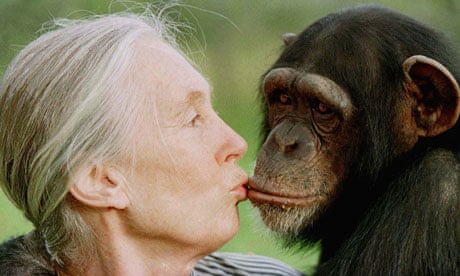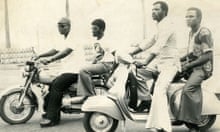Fifty years ago, a slender young Englishwoman was walking through a rainforest reserve at Gombe, in Tanzania, when she came across a dark figure hunched over a termite nest. A large male chimpanzee was foraging for food. So she stopped and watched the animal through her binoculars as he carefully took a twig, bent it, stripped it of its leaves, and finally stuck it into the nest. Then he began to spoon termites into his mouth.
Thus Jane Goodall made one of the most important scientific observations of modern times in that remote African rainforest. She witnessed a creature, other than a human, in the act not just of using a tool but of making one. "It was hard for me to believe," she recalls. "At that time, it was thought that humans, and only humans, used and made tools. I had been told from school onwards that the best definition of a human being was man the tool-maker – yet I had just watched a chimp tool-maker in action. I remember that day as vividly as if it was yesterday."
Goodall telegraphed her boss, the fossil-hunter Louis Leakey (father of Richard), with the news. His response has since become the stuff of scientific legend: "Now we must redefine man, redefine tools, or accept chimpanzees as humans." Leakey was exaggerating but not by much. Certainly, there is little doubt about the importance of Goodall's discovery five decades ago. As the distinguished Harvard palaeontologist Stephen Jay Gould put it, this was "one of the great achievements of 20th-century scholarship".
Goodall's subsequent observations found that not only did Pan troglodytes – the chimpanzee – make and use tools but that our nearest evolutionary cousins embraced, hugged, and kissed each other. They experienced adolescence, developed powerful mother-and-child bonds, and used political chicanery to get what they wanted. They also made war, wiping out members of their own species with almost genocidal brutality on one occasion that was observed by Goodall.
This work has held up a mirror, albeit a blurred one, to our own species, suggesting that a great many of our behaviours, once thought to be uniquely human, may have been inherited from the common ancestors that Homo sapiens shared with chimpanzees six million years ago. We therefore have much to commemorate 50 years after Goodall began her strolls through Gombe. These celebrations began yesterday at the Berlin film festival with the premiere of Lorenz Knauer's documentary about Goodall, Jane's Journey – which includes a walk-on part for Angelina Jolie – and will continue throughout the year.
Today, Goodall is a gracefully aged replica of the young woman who first set foot at Gombe five decades ago. Her long blond hair, tied back as usual, has turned silvery grey. Now aged 76, she exudes a calm confidence as she travels the world, promoting green causes established by the Jane Goodall Institute, which she set up in 1977 in order to promote research at Gombe and to protect chimpanzees and their habitats.
But in 1960, she looked an unlikely scientific pioneer. Goodall had no academic training, having grown up in the middle-class gentility of Bournemouth in the postwar years, a time when women were expected to be wives and little else. However, she burned with two passions: a love of animals and a love of Africa. "I got my love of animals from the Dr Dolittle books and my love of Africa from the Tarzan novels," she says. "I remember my mum taking me to the first Tarzan film, which starred Johnny Weissmuller, and bursting into tears. It wasn't what I had imagined at all."
A friend took a job in Kenya, and Goodall decided to join her, working as a waitress to raise funds for her trip. In Nairobi, Goodall was introduced to Louis Leakey, the scientist whose fossil discoveries had finally proved mankind's roots were African, not Asian, as had previously been supposed.
At this time, Leakey was looking for someone to study chimpanzees in the wild and to find evidence of shared ancestry between humans and the great apes. Previous studies of primates had been confined to captive animals but Leakey believed, presciently, that much more could be learned by studying them in the wild. More to the point, Goodall would make a perfect observer, he believed, coming – as she did – "with a mind uncluttered and unbiased by theory", a point that is acknowledged by Goodall.
There was slightly more to the relationship than this, however. Leakey found the presence of this pretty, hazel-eyed blonde too much for him and although then in his late 50s, and married with three children, he bombarded Goodall with protestations of his love. "I was in a very difficult position, because on the one hand I hugely admired him," says Goodall. "He knew so much. He also had my whole future in his hands. On the other hand, I thought: 'No thanks.'"
Their friendship survived the incident and Goodall went off to Gombe to study her chimpanzees, while Leakey selected two other female researchers, Dian Fossey and Birute Galdikas, to study gorillas and orangutans. Galdikas, like Goodall, is still going strong. The fate of Fossey, played by Sigourney Weaver in the film Gorillas in the Mist, was to be a grim one, however. Fossey was murdered in 1985 after trying to punish local people following incidents in which several of her beloved gorillas were killed.
"Dian was a tragic figure," says Goodall. "She was very, very tall, statuesque and really, really wanted to get married. She would say to people, 'Do you know a man who is six foot five and loves gorillas?' So she got a little bitter later on when I got married and Birute got married and she didn't. And she wasn't diplomatic. She tackled poachers by chasing them and did things that I would not have been brave enough to have done. Sometimes she was very stupid. But she brought the plight of the gorillas to everyone's attention."
The violent death of Dian Fossey contrasts with Goodall's relatively peaceful time in Tanzania, although her life at Gombe – on the eastern shore of Lake Tanganyika, north of Kigoma – certainly did not lack incident. "I arrived with my mother because the local authorities were adamant that a young English girl could not live on her own in the bush without a European escort," she says.
In fact, this ruling may not have been an altogether bad thing because the Belgian Congo had just erupted into civil war and Kigoma was filled with refuges. "There was nowhere to go so we had to put up our tent in a prison camp. They said that was the safest place for us and wouldn't let us go to Gombe for several weeks."
Eventually the two women (plus a cook) made it to the reserve and Goodall began the tricky business of getting Gombe's chimps to accept her. "I remember my first day, looking up from the shore to the forest, hearing the apes and the birds, and smelling the plants, and thinking this is very, very unreal," she says. "Then I started walking through the forest and as soon as a chimp saw me, it would run away."
After a few weeks one male, who she named David Greybeard because of his white-tufted chin, let her approach him – tempted by the odd banana – and allowed her to observe him as he foraged for food. (It was David Greybeard who Goodall later watched making that leafy tool to obtain termites.) More and more troop members followed suit and Goodall was eventually allowed to observe their behaviour almost as if she was a chimpanzee herself.
Slowly she built up a picture of chimp life in all its domestic detail: the grooming, the food-sharing, the status wrangles, and the fights. Goodall gave her chimps names – David Greybeard, Flint, Goliath, Passion, Frodo and Fifi – much to the irritation of academics.
At this time scientists were particularly sensitive about giving human attributes to animals. Anthropomorphism was simply not on, they told Goodall when, in the early 60s, she took a PhD at Cambridge at the insistence of Leakey – who was desperate for his protege to gain academic respectability. "These people were trying to make ethology a hard science," Goodall recalls. "So they objected – quite unpleasantly – to me naming my subjects and for suggesting that they had personalities, minds and feelings. I didn't care. I didn't want to become a professor or get tenure or teach or anything. All I wanted to do was get a degree because Louis Leakey said I needed one, which was right, and once I succeeded I could get back to the field."
In any case, Goodall (who got her PhD in 1965) believes it is simple nonsense to say that animals, particularly chimpanzees which are so closely related to humans, do not have personalities. "You cannot share your life with a dog, as I had done in Bournemouth, or a cat, and not know perfectly well that animals have personalities and minds and feelings. You know it and I think every single one of those scientists knew it too but because they couldn't prove it, they wouldn't talk about it. But I did talk about it. In a way, my dog Rusty gave me the courage of my convictions."
In 1964 Goodall married wildlife photographer Baron Hugo van Lawick – becoming Baroness Jane van Lawick-Goodall. Three years later, the couple had a son, Hugo, who was raised at Gombe where he known simply as "Grub". The presence of lots of chimpanzee mothers had a considerable influence on the way Goodall raised Hugo.
"There are certain characteristics that define a good chimp mother," she says. "She is patient, she is protective but she is not over-protective – that is really important. She is tolerant but she can impose discipline. She is affectionate. She plays. And the most important of all: she is supportive. So that if her kid gets into a fight, even if it is with a higher-ranking individual, she will not hesitate to go in and help."
Goodall contrasts the behaviour of Flo, a good mother, with that of Passion, a poor one. "It was a common sight to see Passion walking along followed by a whimpering infant who was frantically trying to catch up and climb aboard her for transport," Goodall records in her book In the Shadow of Man. By contrast, Flo's child Fifi was a noticeably confident adolescent, Goodall states, "her relaxed behaviour with her elders stemming from the fact that she enjoyed a particularly friendly relationship with her mother".
Fifi's strong start in life was to have profound effects. She too became a good mother and produced many grandchildren for Flo while Passion had relatively few. There is reproductive advantage in good motherhood, in other words.
Being a patient, playful, protective mother is largely common sense, adds Goodall, who is scornful of child-rearing books that suggest otherwise. "Do you pick up a crying baby or do you leave it to cry?" she asks. "Let's just say I picked my baby up when he cried." Gina Ford, please take note.
Van Lawick and Goodall divorced and she later married Derek Bryceson, then director of Tanzania's national parks. His subsequent death in 1978, of cancer, left her devastated.
Around this time, Goodall noted a split was taking place among Gombe's chimpanzees. Eventually, two groups were created – a new, relatively small troop set up in the south, leaving the northern part under the control of the original Gombe population. "Once the original community realised they were the stronger of the two groups, and that there were still more of them than the others, they went for the split-off group," says Goodall.
"There were gang attacks of extraordinary brutality. The male chimps pounded and pounded their victims and left them to die of awful injuries. They did things to their fellow chimps that they would never do within a community but which they do when they are trying to kill a prey animal." It was the equivalent, in our own species, of dehumanising the enemy, a frequent prelude to an atrocity.
"The war was a disaster," says Goodall. "It was awful, not just for the chimps but for me. I thought they were like us but nicer. It was a real shock to see what they did to each other. That is why it was so dreadful."
The parallels between Homo sapiens and Pan troglodytes are deep and numerous, we now know – thanks to Goodall. Equally, there are the crucial differences that divide our species. "The most important one is straightforward," says Goodall. "We have language and they do not. Chimps communicate by embracing, patting, looking – all these things. And they have lots of sounds. But they cannot sit and discuss. They cannot teach about things that are not present, as far as we know."
And this takes us to the heart of Goodall's discoveries about the nature of the chimpanzee and its implications for our understanding of our nature. Language and discussion develop the intellect, she argues. "The brain of a chimp and the brain of a human are not that different anatomically. But we started to talk to each other and that drove the brain – because there were more and more things that we could do with it.
"Chimps can do all sorts of things we thought that only we could do – like tool-making and abstraction and generalisation. They can learn a language – sign language and they can use the signs. But when you think of our intellects, even the brightest chimp looks like a very small child."
Clearly, we have learned a great deal not just about our evolutionary cousins but about ourselves thanks to the work that Goodall began at Gombe 50 years ago and to the other chimp observation projects that have been set up in the wake of her study. The tragedy is that many of these programmes are now threatened by the current catastrophic decline in population of the chimpanzee across Africa. One hundred years ago, there were two million of them. Today there are less than 200,000, with habitat destruction and bushmeat trade being responsible for the loss of increasing numbers.
Many populations are now poised at the edge of eradication – taking with them our chance to learn about their unique cultures, for chimps vary from place to place in the manner in which they catch termites or baboons, a knowledge that is passed down from adult to child.
The implications for science and for our understanding of ourselves are profound, as Stephen Jay Gould makes clear in his introduction to the revised edition of Goodall's In the Shadow of Man. "We can never know, by studying ourselves alone, whether important aspects of our mental capacities reflect an ancestral evolutionary heritage or new features evolved or socially acquired by our lineage. Chimpanzees are the best natural experiment we will ever have for exploring this central question."
Yet at the present rate that the habitat of these wonderful creatures is being destroyed, that great natural experiment is likely to be brought to an abrupt end only a few decades after Goodall began her work. Hence her efforts to raise awareness of their plight and her involvement in a range of international projects – including Roots & Shoots, her environmental youth programme – which are aimed at protecting African habitats and chimpanzee homelands.
"At the end of the day, I still think we can do it," she says. "Everywhere I go there are young people with shining eyes wanting to tell Dr Jane what they are doing to make the world better. You have to be hopeful."






